(출처:Wikipedia)
그런데 이 정도의 간략한 가계도는 단권짜리 축약판에나 어울리지, 완역 『마하바라따』에는 어울리지 않지 싶다. 이 거대한 서사시에 걸맞은 가계도 정도라면, 1-70, 1-89(『마하바라따』 1장 태동, 70과 89)에서 언급된 “닥샤 쁘라자빠띠, 마누 와이와스와따, 바라따, 꾸루, 뿌루, 아지마다 계보에 속하는 성스럽고 다복하며 풍요와 명예와 장수를 누린 야다와, 빠우라와, 그리고 바라따의 모든 가계”를 올리는 게 어울리지 않을까? Penguin Books에서 출간한 2010년 판 『Mahabharata』에서는 그런 무시무시한 작업의 결과가 실려 있다.
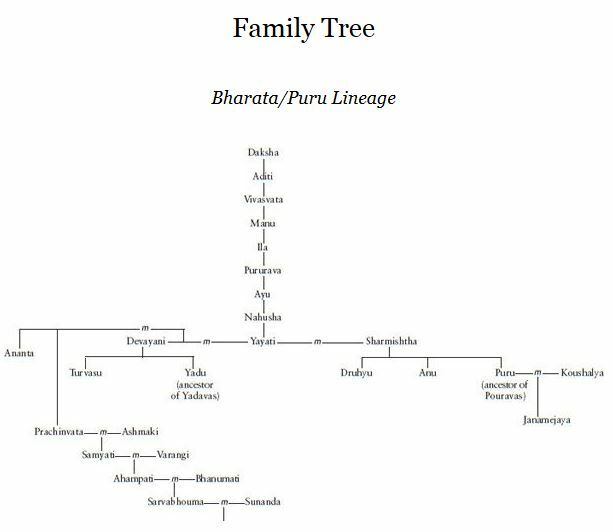
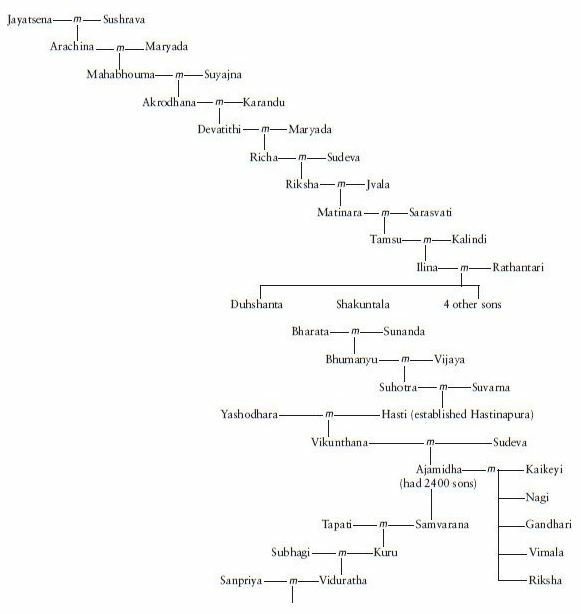
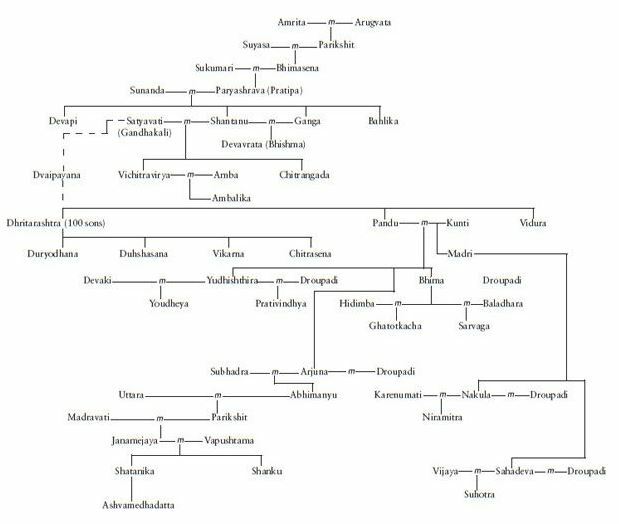
§ 일러두기 (1권 p.24, 2권 p.461, 3권 p.5)
1. 이 책은 뿌네의 반다르까 동양학 연구소에서 편찬한 보리(BORI)본을 원전으로 삼아 옮겼으며, 이야기의 흐름상 필요한 경우에는 다른 이본의 이야기들을 삽입하고 주에 따로 표시해두었다.
새물결에서 출간한 『마하바라따』는 뿌네(Pune)의 반다르까 동양학 연구소(Bhandarkar Oriental Research Institute, BORI)의 판본을 원전으로 삼았다고 했다. 이 보리본을 Critical Edition, 일명 결정판이라고 하는데, 이 설명이 빠져 있어서 조금 적는다. 『마하바라따』는 약 1천여 년에 걸쳐 완성된 작품이므로, 수많은 판본, 혹은 교정본이 존재한다. 뿌네의 반다르까 동양학 연구소가 이 수많은 판본을 취합, 후대에 추가된 이야기들을 삭제하면서 제작한 것이 바로 결정판이다. 1919년에 시작해서 1966년에야 출간했는데, 이때는 부록인 ‘하리 왕가’가 빠져 있었으며, 1970년에야 ‘하리 왕가’를 부록으로 추가, 진짜 결정판을 출간했다. 이 결정판이야 말로 진정으로 ‘공인된’ 판본이라 할 수 있는데, 문제는 다른 판본에서 설명을 위해 삽입했던 구절들이 후대에 추가된 것들이라는 이유로 삭제가 되어서 이야기 진행이 널을 뛴다는 데 있다. 오히려 이본(異本)들이 이야기를 이해하는 데 더 낫다는 것인데, 역자도 그렇게 생각해서인지 삭제된 부분을 추가로 집어넣었다. 추가된 부분은 1-107 (2권 p.515), 1-119(2권 p.558), 1-215(2권 p.879)에서 확인할 수 있다.
그런데 결정판에는 매우 유명한 두 개의 이야기가 삭제되어 있다. (더 있을 수도 있다. 하지만 3권까지 읽었을 때 확인할 수 있었던 것은 이 두 이야기들이다.) 하나는 이 위대한 이야기의 저자인 위야사와 가네샤에 대한 이야기, 다른 하나는 드라우빠디와 끄르슈나에 대한 이야기이다. 역자는 다른 삭제된 이야기들은 집어넣었으면서 왜 이토록 유명한 이야기들은 언급조차 하지 않았을까?
먼저 위야사와 가네샤에 대한 이야기. 위야사는 이 위대한 이야기를 생각해냈지만, 이를 기록할 사람이 없었다. 그러자 창조주 브라흐마는 가네샤를 보내어 이를 받아 적게 했다. 가네샤는 위야사가 낭송을 하되 절대 멈추지 않고 계속 낭송을 한다면 받아 적겠다는 조건을 걸었다. 그러자 위야사는 자신이 이야기하는 각 시구의 의미를 깨닫고 이해해야만 가네샤가 기록을 할 수 있다는 조건을 내세웠다. 가네샤는 이를 받아들였으며, 위야사는 낭송을 시작했고 가네샤는 기록을 시작했다. 때때로 위야사는, 가네샤를 당황스럽게 하고 생각할 시간을 주기 위해, 아리송한 단어들을 선택하고 이야기 구성을 비틀었다고 한다. (그래서 『마하바라따』가 그토록 복잡한 구성을 하고 있는 것이다! 신조차도 생각에 빠져 집필을 멈춰야 했으니 인간들은 오죽하겠는가!)
이 이야기는 1-1 (『마하바라따』 1권 p.45)에서 삭제된 이야기인 듯하며, 삭제된 부분은 Ganguli의 번역본에서 찾아볼 수 있다. (Ganguli가 번역했을 때에는 결정판이라는 게 존재하지 않았으니...) Peter Brook의 작품(연극/영화)에도 이 이야기가 언급되어 있다.
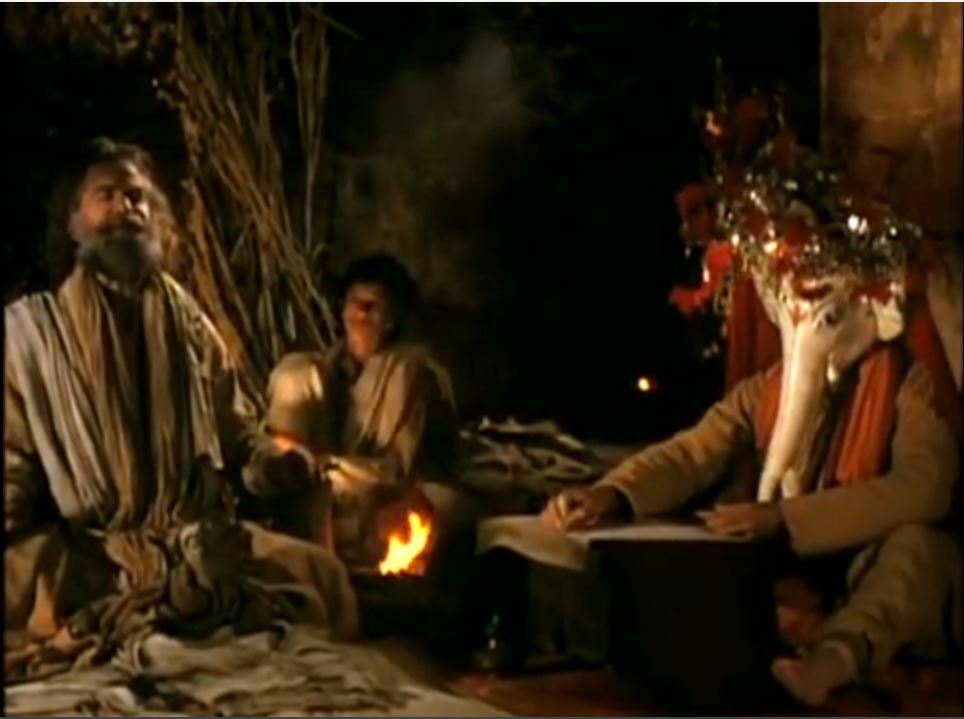
1989년 영화. Peter Brook 감독. 구술하는 위야샤와 기술하는 가네샤. 그 뒤로 이를 보고 있는 소년의 모습.
Kisari Mohan Ganguli Translation
The son of Satyavati having, by penance and meditation, analysed the eternal Veda, afterwards composed this holy history, when that learned Brahmarshi of strict vows, the noble Dwaipayana Vyasa, offspring of Parasara, had finished this greatest of narrations, he began to consider how he might teach it to his disciples. And the possessor of the six attributes, Brahma, the world's preceptor, knowing of the anxiety of the Rishi Dwaipayana, came in person to the place where the latter was, for gratifying the saint, and benefiting the people. And when Vyasa, surrounded by all the tribes of Munis, saw him, he was surprised; and, standing with joined palms, he bowed and ordered a seat to be brought. And Vyasa having gone round him who is called Hiranyagarbha seated on that distinguished seat stood near it; and being commanded by Brahma Parameshthi, he sat down near the seat, full of affection and smiling in joy. Then the greatly glorious Vyasa, addressing Brahma Parameshthi, said, "O divine Brahma, by me a poem hath been composed which is greatly respected. The mystery of the Veda, and what other subjects have been explained by me; the various rituals of the Upanishads with the Angas; the compilation of the Puranas and history formed by me and named after the three divisions of time, past, present, and future; the determination of the nature of decay, fear, disease, existence, and non-existence, a description of creeds and of the various modes of life; rule for the four castes, and the import of all the Puranas; an account of asceticism and of the duties of a religious student; the dimensions of the sun and moon, the planets, constellations, and stars, together with the duration of the four ages; the Rik, Sama and Yajur Vedas; also the Adhyatma; the sciences called Nyaya, Orthœphy and Treatment of diseases; charity and Pasupatadharma; birth celestial and human, for particular purposes; also a description of places of pilgrimage and other holy places of rivers, mountains, forests, the ocean, of heavenly cities and the kalpas; the art of war; the different kinds of nations and languages: the nature of the manners of the people; and the all-pervading spirit;--all these have been represented. But, after all, no writer of this work is to be found on earth.'
"Brahma said. 'I esteem thee for thy knowledge of divine mysteries, before the whole body of celebrated Munis distinguished for the sanctity of their lives. I know thou hast revealed the divine word, even from its first utterance, in the language of truth. Thou hast called thy present work a poem, wherefore it shall be a poem. There shall be no poets whose works may equal the descriptions of this poem, even, as the three other modes called Asrama are ever unequal in merit to the domestic Asrama. Let Ganesa be thought of, O Muni, for the purpose of writing the poem.'
"Sauti said, 'Brahma having thus spoken to Vyasa, retired to his own abode. Then Vyasa began to call to mind Ganesa. And Ganesa, obviator of obstacles, ready to fulfil the desires of his votaries, was no sooner thought of, than he repaired to the place where Vyasa was seated. And when he had been saluted, and was seated, Vyasa addressed him thus, 'O guide of the Ganesa! be thou the writer of the Bharata which I have formed in my imagination, and which I am about to repeat."
"Ganesa, upon hearing this address, thus answered, 'I will become the writer of thy work, provided my pen do not for a moment cease writing." And Vyasa said unto that divinity, 'Wherever there be anything thou dost not comprehend, cease to continue writing.' Ganesa having signified his assent, by repeating the word Om! proceeded to write; and Vyasa began; and by way of diversion, he knit the knots of composition exceeding close; by doing which, he dictated this work according to his engagement.
I am (continued Sauti) acquainted with eight thousand and eight hundred verses, and so is Suka, and perhaps Sanjaya. From the mysteriousness of their meaning, O Muni, no one is able, to this day, to penetrate those closely knit difficult slokas. Even the omniscient Ganesa took a moment to consider; while Vyasa, however, continued to compose other verses in great abundance.
The wisdom of this work, like unto an instrument of applying collyrium, hath opened the eyes of the inquisitive world blinded by the darkness of ignorance. As the sun dispelleth the darkness, so doth the Bharata by its discourses on religion, profit, pleasure and final release, dispel the ignorance of men. As the full-moon by its mild light expandeth the buds of the water-lily, so this Purana, by exposing the light of the Sruti hath expanded the human intellect. By the lamp of history, which destroyeth the darkness of ignorance, the whole mansion of nature is properly and completely illuminated.
드라우빠디와 끄르슈나에 대한 이야기는 다음과 같다. (내용 누설이니 간략하게 언급한다면) 두샤사나가 회당에 끌려나온 드라우빠디의 옷을 벗기자 드라우빠디는 끄르슈나에게 간절한 기도를 올린다. 기도에 응답한 끄르슈나가 조용히 나타나 드라우빠디의 몸이 드러나지 않도록 끊임없이 옷이 나오게 했다.
생략된 부분은 2-61 (『마하바라따』 3권 p.258 11째 줄) 부분이고, 끄르슈나가 등장하지 않음으로써 그저 놀라운 장면으로만 묘사가 되어 있다. 그런데 이 생략된 이야기는 워낙에 강렬한 부분이어서 그런지, 『마하바라따』를 다룬 (거의) 모든 영화와 드라마에서는 이 이야기에 끄르슈나가 등장을 한다. 심지어 결정판이 나온 1970년 이후의 영화와 드라마에서조차도 이 부분만큼은 이본(異本)의 이야기를 따르고 있다. 삭제된 부분은 Ganguli의 번역본에서 찾아볼 수 있다.
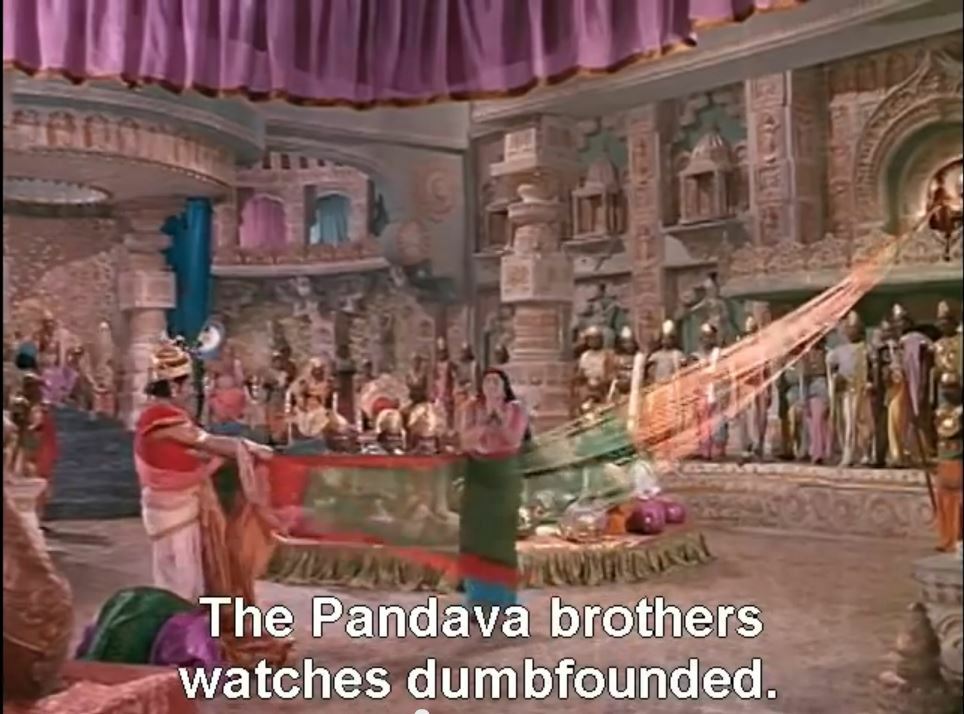
1965년 영화. Babubhai Mistri 감독. 왼편에 두샤사나가 드라우빠디의 옷을 당기고 있고 오른편에 끄리슈나가 천을 내리고 있다. 드라우빠디 뒤편으로 왼편엔 까우라와들이 이를 보고 있고 오른편엔 빤다와들이 옷을 벗은 채 고개를 숙이고 있다.
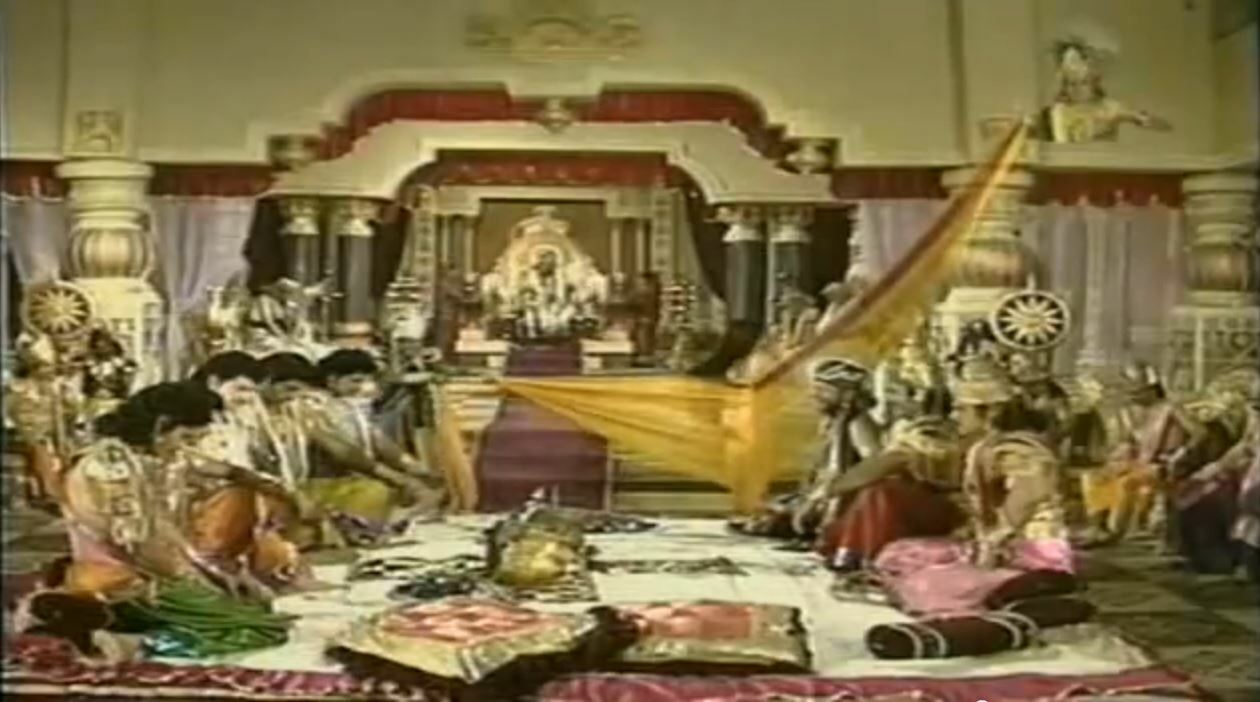
1988년 드라마. B. R. Chopra 제작. Babubhai Mistri의 영화와 거의 같은 구도이다. 단 까우라와들과 빤다와들의 위치가 바뀌었다.
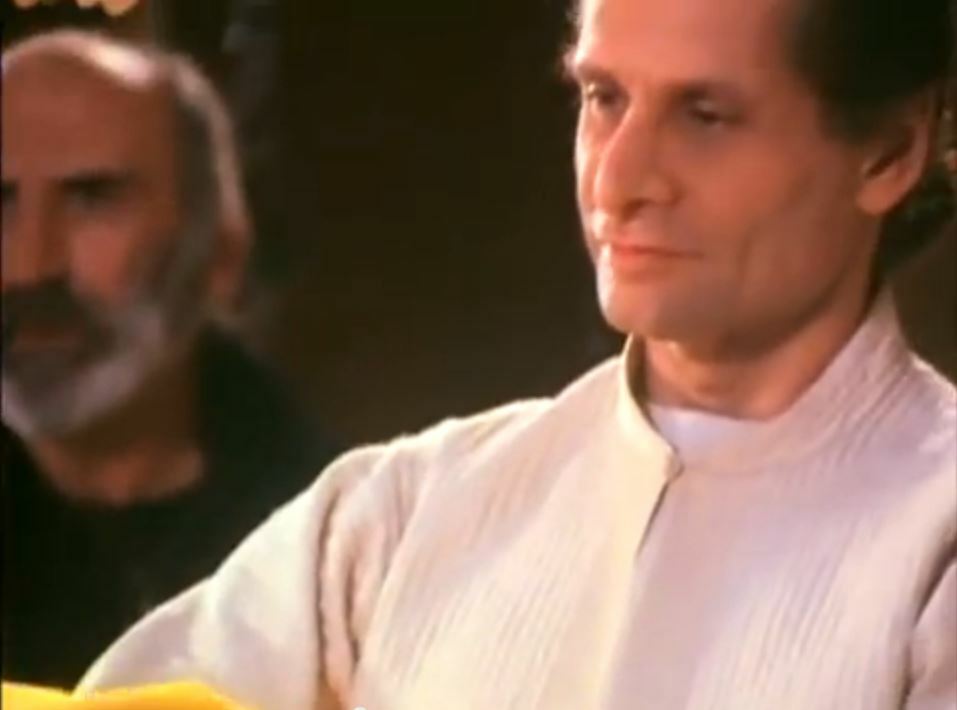 1989년 영화. Peter Brook 감독. 드라우빠디 뒤에서 천을 주고 있는 끄르슈나. 뒤편에 샨따누가 놀란 표정으로 있다. 백인 배우들이 역을 맡고 있는데, 이는 연극을 영화로 담았기 때문이다.
1989년 영화. Peter Brook 감독. 드라우빠디 뒤에서 천을 주고 있는 끄르슈나. 뒤편에 샨따누가 놀란 표정으로 있다. 백인 배우들이 역을 맡고 있는데, 이는 연극을 영화로 담았기 때문이다.
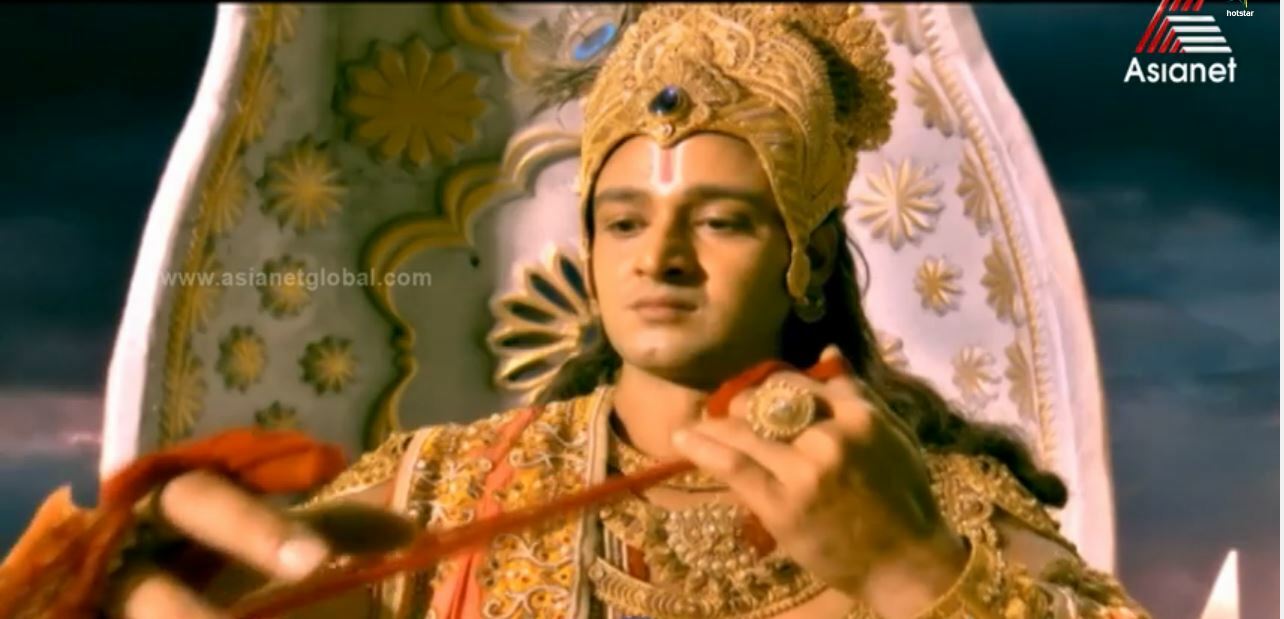
2013년 드라마. Swastik Pictures 제작. 천상에서 끄르슈나가 천을 내리고 있다. 이 에피소드만으로 한 회를 진행한다. (한 회가 20분 분량이긴 하지만...)
Kisari Mohan Ganguli Translation
Vaisampayana continued,--"When the attire of Draupadi was being thus dragged, the thought of Hari, (And she herself cried aloud, saying), 'O Govinda, O thou who dwellest in Dwaraka, O Krishna, O thou who art fond of cow-herdesses (of Vrindavana). O Kesava, seest thou not that the Kauravas are humiliating me. O Lord, O husband of Lakshmi, O Lord of Vraja (Vrindavana), O destroyer of all afflictions, O Janarddana, rescue me who am sinking in the Kaurava Ocean. O Krishna, O Krishna, O thou great yogin, thou soul of the universe, Thou creator of all things, O Govinda, save me who am distressed,--who am losing my senses in the midst of the Kurus.' Thus did that afflicted lady resplendent still in her beauty, O king covering her face cried aloud, thinking of Krishna, of Hari, of the lord of the three worlds. Hearing the words of Draupadi, Krishna was deeply moved. And leaving his seat, the benevolent one from compassion, arrived there on foot. And while Yajnaseni was crying aloud to Krishna, also called Vishnu and Hari and Nara for protection, the illustrious Dharma, remaining unseen, covered her with excellent clothes of many hues. And, O monarch as the attire of Draupadi was being dragged, after one was taken off, another of the same kind, appeared covering her. And thus did it continue till many clothes were seen. And, O exalted on, owing to the protection of Dharma, hundreds upon hundreds of robes of many hues came off Draupadi's person. And there arose then a deep uproar of many many voices. And the kings present in that assembly beholding that most extraordinary of all sights in the world, began to applaud Draupadi and censure the son of Dhritarashtra. And Bhima then, squeezing his hands, with lips quivering in rage, swore in the midst of all those kings a terrible oath in a loud voice.
§ 일러두기 (1권 p.24, 2권 p.461, 3권 p.5)
2. 이 책은 전부 18장으로 구성되어 있지만 각 장의 분량이 동일하지 않아 몇몇 장은 2~3권으로 분권된다. 이와 관련해 각 장의 권수 표시와 부제는 편집부에서 따로 작성한 것이다.
장, 권, 이 말들에 대한 용어가 먼저 확립이 되어야 할 것 같다. 『마하바라따』는 약 10만여 개의 shlokas(시구)로 구성되어 있다고 한다. 결정판은 정확히 (부록인 하리 왕조를 포함하여) 79,857개의 shlokas로 이루어져 있다. 이 shlokas가 모여 작은 이야기 단위를 이룬 게 adhyaya(소단원)고, 현재의 챕터 구성과 같은 방식이다. 그리고 이 adhyayas가 모인 게 parva다. 『마하바라따』는 분류하는 방식에 따라 18개 또는 100개의 parvas로 나뉜다.(결정판에서는 부록을 포함해 정확히 19개/98개지만, 관용적으로 18개/100개라고 한다.) 18개로 분류하는 것은 현재의 분권 형식에 가깝고, 100개 분류는 소제목 혹은 section 형식에 가깝다.
아쉬운 점은, 새물결의 편집부는 19개의 parvas와 각 adhyaya도 결정판에서 분류한 대로 따랐지만, 98개의 parvas로 분류한 것은 따르지 않고 편집부 임의대로 나누었다는 점이다. (그래서 1권 p.79에 그에 대한 각주가 달려있다.) 이런 분류 방식은 일장일단이 있는데, 장점은, 하나의 완결된 이야기마다 소제목으로 구분을 해서 내용을 쉽게 이해할 수 있다는 점이고, 단점은, 원본의 형태가 어떤지 알 수 없다는 점이다. 최소한 원본이 어떻게 분류되어 있는지 알려주었더라면 좋았을 텐데. 아쉽다. 그래서 염치없게도 Bibek Debroy가 분류한 것을 옮겨 놓는다.
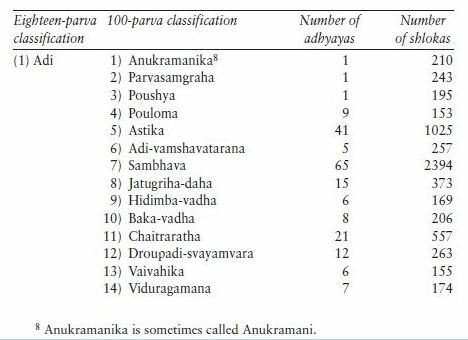
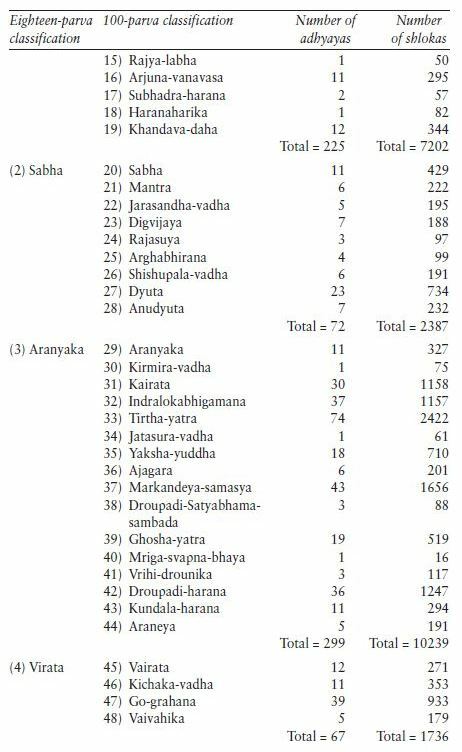
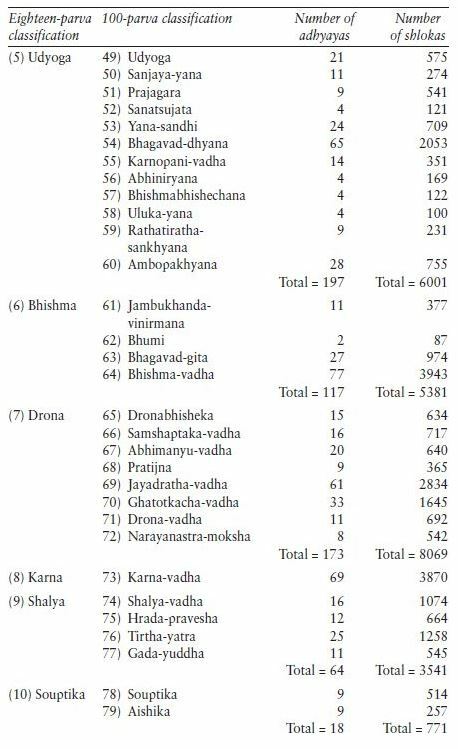
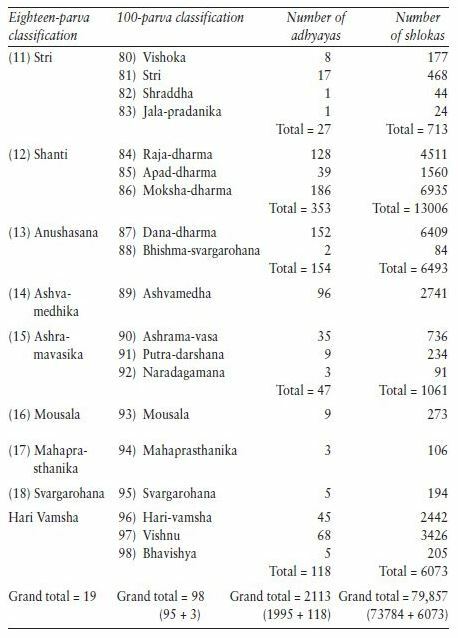
그리고 분권 형식에 대한 걱정이 있는데, 영역본의 경우엔 parva에 관계없이 대개 10권 정도의 볼륨으로 나뉜다. 표에서 확인할 수 있듯이, 각 parva의 볼륨이 들쭉날쭉해서 parva에 맞추어 책을 출간하기는 쉽지 않기 때문이다. 보통은 Adi parva를 1권으로 맞추고 그에 맞게 볼륨을 조절하는데, 새물결 판본은 각 parva에 맞추어 책을 출간하고 있다. 그래서 각 권마다 볼륨이 제각각이다. parva에 맞춘다면 Mousala parva는 거의 팸플릿 수준일 텐데... 뭐 20권에 맞춰서 출간할 계획이라니까 아마 방법이 있을 것이다.
그리고 또, 뱀다리. 위 표에 따르면 결정판에서 부록인 하리 왕조는 6,073개의 shlokas로 구성되어 있는 것을 알 수 있다. 그러므로 1권과 2권 뒤에 있는 부록 1(p.462, p.918)에서 “『하리왕샤』의 16,000개의 시구”는 수정되어야 할 것이다.
§1권 p.36 각주 나라야나와 나라
『마하바라따』에서 나라야나는 주인공 아르주나와, 나라는 전지전능한 끄르슈나와 동일시된다.
→ 『마하바라따』에서 나라는 주인공 아르주나와, 나라야나는 전지전능한 끄르슈나와 동일시된다.
나라와 나라야나가 반대로 명시되어 있다.
The Hindu epic Mahabharata identifies the god Krishna (an avatar of Vishnu) with Narayana and Arjuna - the chief hero of the epic - with Nara. The legend of Nara-Narayana is also told in the scripture Bhagavata Purana. Hindus believe that the pair dwells at Badrinath, where their most important temple stands.
(출처:Wikipedia)
§1-1 (『마하바라따』 1권 p.37 1째 줄)
로마하르샤의 아들 우그라쉬라와스, 떠돌이 가객이자 옛이야기에 달통한 그가 나이미샤 숲에 들었다. 숲에서는 샤우나까를 수장으로 열두 해째 희생제가 거행되고 있었다. 엄격히 서약을 지키며 함께 모여 수행하던 제석천의 선인(仙人)들에게 가객이자 가객의 아들이기도 한 우그라쉬라와스가 공손하게 예를 갖추었다.
Bibek Debroy Translation (Critical Edition)
The great sages, performers of difficult austerities, were present at the twelve-year sacrifice of Kulapati Shounaka and were comfortably seated in Naimisharanya. Ugrashrava, the son of Lomaharshana and the son of suta, learned in the Puranas, and also known as Souti, once approached them, bowing in humility.
Kisari Mohan Ganguli Translation
Ugrasrava, the son of Lomaharshana, surnamed Sauti, well-versed in the Puranas, bending with humility, one day approached the great sages of rigid vows, sitting at their ease, who had attended the twelve years' sacrifice of Saunaka, surnamed Kulapati, in the forest of Naimisha.
Debroy의 번역이건 Ganguli의 번역이건, 『마하바라따』에서 ‘우그라쉬라와스’의 이름 표기는 처음에 한 번 나오고 이후는 계속 ‘사우띠(Souti/Sauti)’로 표기된다. 그런데 역자(박경숙)는 ‘우그라쉬라와스’로 고정시켰다. 역자는 1권과 2권 뒤에 있는 부록 1(p.467, p.923)에서 “가객의 아들(사우띠)이자 본인도 가객인 우그라쉬라와스”라고 이야기했는데, Bibek Debroy는 ‘사우띠’를 우그라쉬라와스의 가문(혈통)을 나타내는 말이라 했고(Souti refers to his birth.), Ganguli는 성(姓)이라고 번역했다. 뭐가 맞는 표현일까? 만약에 사우띠가 ‘가객의 아들’이라는 뜻이 맞는다면, ‘우그라쉬라와스가 말했다.’는 모두 ‘가객의 아들이 말했다.’로 바꾸어야 할 것이다. 왜냐하면 『마하바라따』의 등장인물들은 하나의 이름으로 고정되지 않고 여러 이름으로 불리기 때문이고, 역자 역시 그 이름들 옆에 친절하게 누가 누구인지를 표기해주었기 때문에 우그라쉬라와스만 특별대우를 할 이유는 없기 때문이다.
본래는 싼스끄리뜨 원본과 비교해야 하지만, 알지 못하니 차선책으로 다른 번역본을 비교해봤다. 이들 번역본이 원본과 일치한다는 보장은 없으므로 하나 마나 한 일이 될 터이나,(Debroy는 자신의 번역이 이전의 번역들보다 더 낫고 정확하다고 자부하긴 한다.) 비교해 보고픈 욕망을 차마 거스를 수 없었다. 참고로 Bibek Debroy의 영역은 2010년에 Penguin Books에서 출간됐으며, 박경숙의 번역과 같이 결정판(Critical Edition)을 번역했다. Kisari Mohan Ganguli의 영역은 1883년(!)에 출간됐고(이후 1896년 완간!) 최초의 영역본이며 저작권 소멸로 인터넷에 공개되어 있다.
§1-53 (『마하바라따』 1권 p.267)
adhyaya번호가 빠져 있다. 본문 위에 ‘53’ 추가.